
Year ago, when I first visited Kyoto, I visited Sushi no Musashi, considered by many to be the best conveyor belt sushi in Kyoto. At that time, I visited their location near Nishiki Market.
Years later, I still remember that visit. The sushi was fresh, affordable, and I loved having the option of picking and choosing whatever sushi I wanted from the conveyor belt (kaiten sushi).
Today, Sushi no Musashi, which was founded in 1977, operates three stores in Kyoto. They have stores near Nishiki Market, in northern Kyoto, and one at Kyoto Station.
On my recent visit to Kyoto, I decided to venture over to their Hachijoguchi store located on Asty Road inside JR Kyoto Station.
If you are looking for more information about Kyoto, Osaka, and Japan, I highly recommend you pick up a guidebook such as Lonely Planet Pocket Kyoto & Osaka.
Table of Contents
Expect a Line at Sushi No Musashi Hachijoguchi
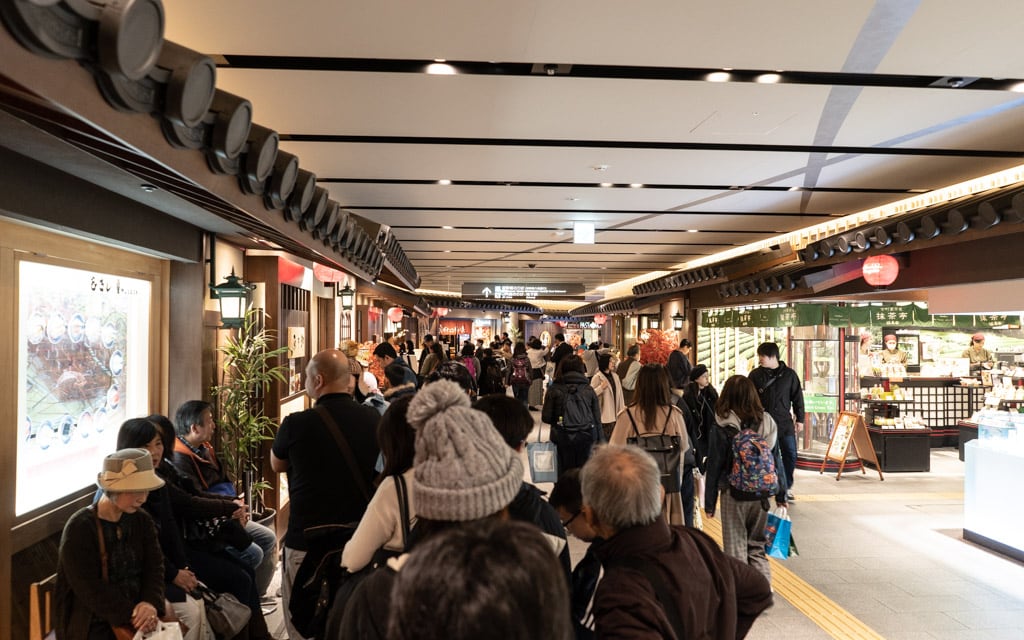
When you enter Asty Road at Kyoto Station, it’s hard to miss Sushi no Musashi. There is always a line out front.
I heard the wait was worth it, so I got in line and patiently waited like everyone else. I have heard horror stories about the line taking hours. Fortunately, on my visit, I only waited about 30 minutes before my seat at the counter was ready.
Don’t feel like waiting in line? Then you are in luck. Sushi no Musashi offered sushi to go.
There was a great selection of sushi to go options. This included traditional sushi rolls, nigiri, makizushi (rolled sushi), and gunkan-maki (batteship sushi). Sushi options started at 315 yen which was quite affordable.

Sushi no Musashi had a bright open interior. At the center of the restaurant were sushi chefs dressed in white coats and hats. These chefs were working diligently, creating plate after plate of fresh sushi.
Wrapping around the restaurant was a rectangle-shaped counter. If you are wondering, there was counter only seating.

As with other conveyor belt sushi restaurants, at Sushi no Musashi you had the option of ordering freshly prepared sushi plates or picking and choosing from the conveyor belt.
If you want to order a freshly prepared dish, let the staff know. They will then notify the chefs. After a few minutes, one of the chefs will hand you your freshly prepared dish.
Sushi no Musashi Menu


If you are planning to order a la carte from the sushi chefs, which I recommend, then take a look at the sushi menu. Each item was clearly listed in English and Japanese. The photos made ordering from the servers a breeze, even with the language barrier. Just grab the attention of a server and point to what you want.
Unfortunately, on my visit, they were out of many great options. The unavailable options were covered by a red dot on the menu.
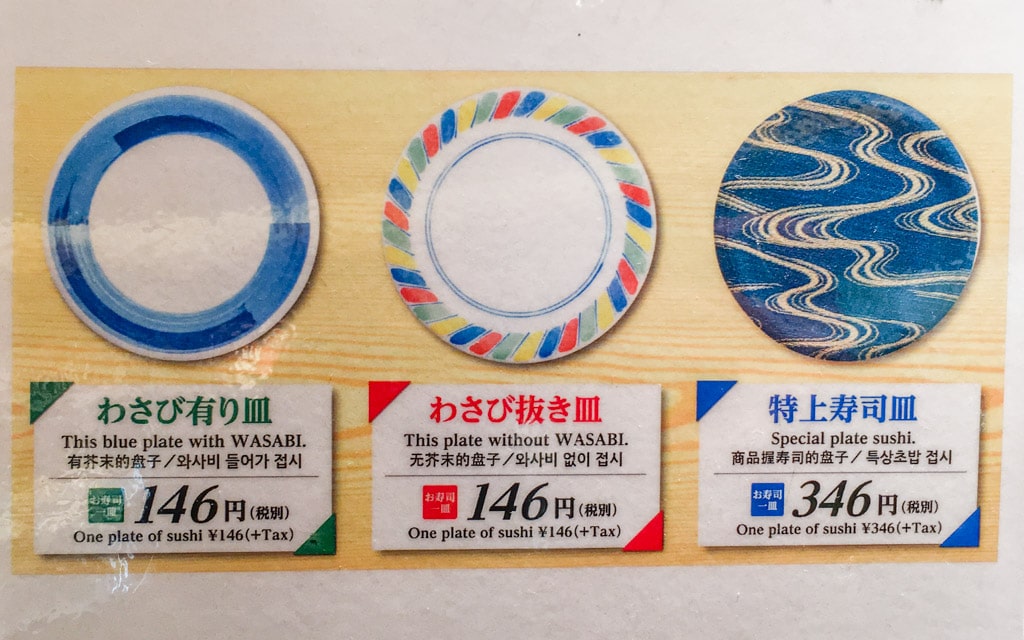
The pricing system at Sushi no Musashi was simple compared to other conveyor belt sushi restaurants. You only had three types of plates.
The blue plate with a white center was 146 yen. This plate included wasabi. The rainbow plate with a white center was 146 yen. This plate was without wasabi. The all blue plate was 346 yen.
On the counter was everything you needed. There was an assortment of sauces, ginger, and green tea packets. The sauces include soy sauce, sweet soy sauce, and ponzu sauce. There was also a large bottle of wasabi. I don’t think I have ever seen so much wasabi.
The sliced ginger was quite spicy, so go easy on it.
Raw Shrimp (Namaebi) – 146 Yen

First up was the Raw Shrimp (Namaebi).
While thin, the shrimp had a great meaty texture and bite. There were no stringy bits to be found but the shrimp was more chewy than I was expecting.
The shrimp was not as flavorful as I would have hoped. It was nothing like sweet shrimp. It’s flavor wasn’t horrible but it had a strong, almost harsh briny flavor.
Not bad but not my favorite.
Broiled Eel (Aburi Unagi) – 146 Yen
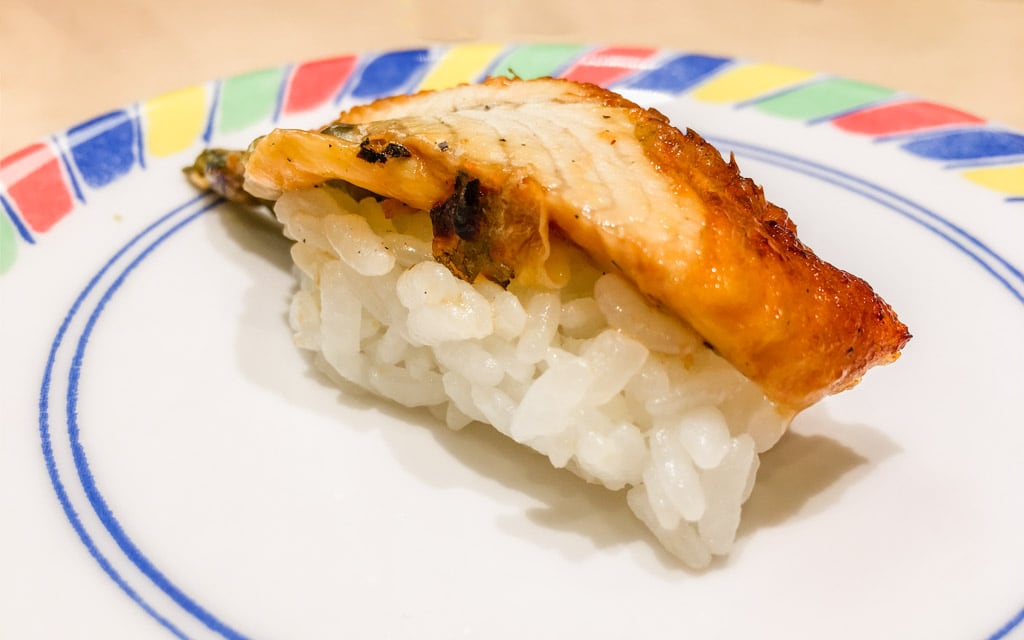
If you have never had Broiled Eel (Aburi Unagi) before, then you are missing out.
It might seem strange, but eel is delicious, especially when it’s seared or broiled.
On its own, eel is sweet and salty. Once it is broiled, all the umami flavors are revealed. The smoky aroma from the sear mixed with the sweetness and saltiness of the eel was amazing.
You might be wondering about the texture of the eel. Since the eel was broiled, it was cooked all the way through. This resulted in a meaty, flaky texture. It was so tender that it almost melted in my mouth.
Though there was only one piece, I highly recommend the broiled eel.
Scallop Shell Fish (Kaibashira) – 146 Yen

Next up was the Scallop Shell Fish (Kaibashira), one of my favorite types of sushi. If you have never had raw scallops before, then you are missing out.
Though not as thick as I was expecting, these scallops had a meaty texture to them. They were like butter, so tender that they just melted in my mouth.
Even better was the taste. The scallops had a fresh, salty flavor with a hint of sweetness.
Medium Fatty Bluefin Tuna (Hon-Maguro Chu-Toro) – 346 Yen
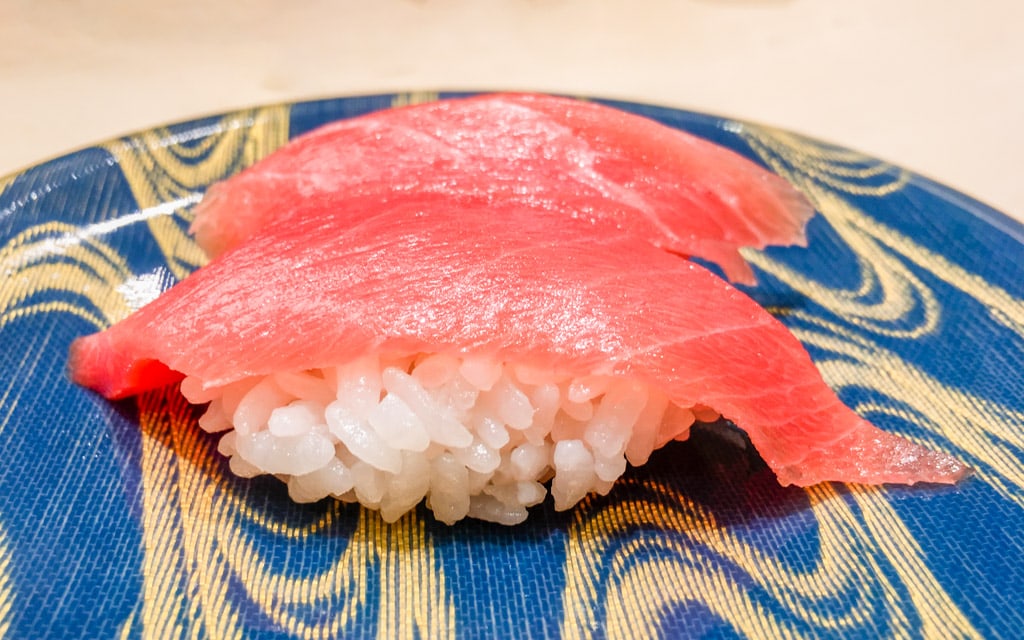
Out of all the sushi I had at Sushi no Musashi, none was more beautiful than the Medium Fatty Bluefin Tuna (Hon-Maguro Chu-Toro). There was another similarly priced option on the menu, the More Fatty Bluefin Tuna (Hon-Maguro Otoro), but unfortunately they were sold out.
As I mentioned before, the tuna was beautiful. Each piece a deep, ruby red. I was hoping it tasted as great as it looked.
The tuna was delicious. It had that same buttery, melt-in-your-mouth texture as the scallops.
Even better were the flavors. Each piece had a fresh, slightly briny flavor. There wasn’t anything fancy to it. Sometimes simple is best, letting the flavors of the fish shine.
The medium fatty bluefin tuna was well worth the price. I could eat this everyday. I just wish they had the more fatty bluefin tuna available. It gives me a reason to return.
Salmon Roe (Ikura) – 146 Yen

The Salmon Roe (Ikura) is a type of battleship sushi or gunkan maki. This type of sushi is made by wrapping seaweed (nori) around rice and then topping it, usually with salmon roe (ikura).
Biting into the salmon roe was like an injection of delicious briny, salty flavors. While the eggs were delicious, they didn’t have that same pop I have come to enjoy.
Though simple, the sliced cucumber placed below the salmon eggs added a much needed fresh, crunchy texture. On the other hand, the seaweed wasn’t as fresh or crunchy as I was expecting. It was missing that light, crispy bite.
Blowfish (Fugu) – 346 Yen

When I saw Blowfish (Fugu) on the conveyor belt, I knew I had to try it.
Blowfish, known as fugu in Japanese, is a delicacy in Japan. It can fetch hundreds of dollars at any restaurant in Tokyo. And, it’s lethally toxic if not prepared correctly.
Fortunately, Japan has strict laws in place with regard to the preparation of fugu. Chefs go through years of training. They learn how to remove toxic parts from the fugu without contaminating the meat. In other words, no need to worry.
The texture of the blowfish was chewy but I wouldn’t say it was stringy or fatty. It had an extra bite to it. I have heard that blowfish causes numbness in the mouth, but I did not experience this.
Unfortunately, the flavors of the blowfish were disappointing. While the ginger and sliced green onions added flavor and texture, the blowfish was otherwise bland. And, it had no wasabi for heat. The blowfish seemed saturated in water, but strangely this liquid was not salty.
Even though the flavors of the blowfish were disappointing, I am glad I can say I tried it (and survived).
Yellowtail (Hamachi) – 146 Yen

I had high expectations for the Yellowtail (Hamachi), but it was forgettable.
The flavor of the yellowtail was quite bland, and salty, though I enjoyed the addition of wasabi for an extra kick of heat and flavor.
‘
While the yellowtail wasn’t chewy or stingy, it didn’t have that melt-in-your-mouth texture that I was hoping for. Each piece had a good bite to it.
I would have to pass on the yellowtail next time with so many other flavorful options on the menu.
Original Egg (Tamago) – 146 Yen

It was hard to miss the bright yellow Original Egg (Tamago). While tamago isn’t something I always eat, it’s a great option when you need a break from seafood.
So what is tamago? It’s basically a Japanese omelette made with multiple layers of cooked eggs.
The egg wasn’t your typical omelette you might make at home. It was sweet and salty, maybe with the addition of soy sauce.
The piece of egg was massive. Somehow it was dense and heavy but fluffy at the same time. This is what I have come to expect in Japan. No where else does it better.
Fatty Salmon (Toro Salmon) – 146 Yen
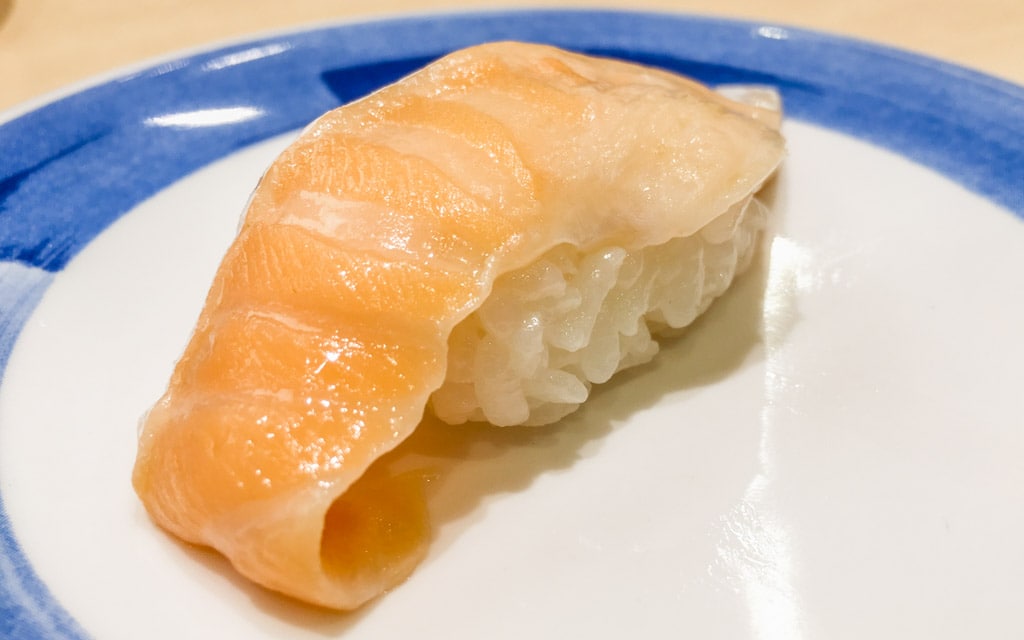
The Fatty Salmon (Toro Salmon) seemed interesting to me when I saw it making its way around the conveyor belt.
Though it was only one piece of sushi, the single piece of fatty salmon was quite large. You can’t really tell in the photo, but there was some white skin left on the fish when it was butchered. I was expecting the skin to be chewy, but it wasn’t an issue.
The salmon had a good bite to it, though I would have preferred it to be more tender. I wanted that melt-in-your-mouth texture.
The fatty salmon had somewhat of a fishy, salty flavor. Not my favorite for sure.
Roast Fatty Salmon (Yaki Salmon Harasu) – 146 Yen
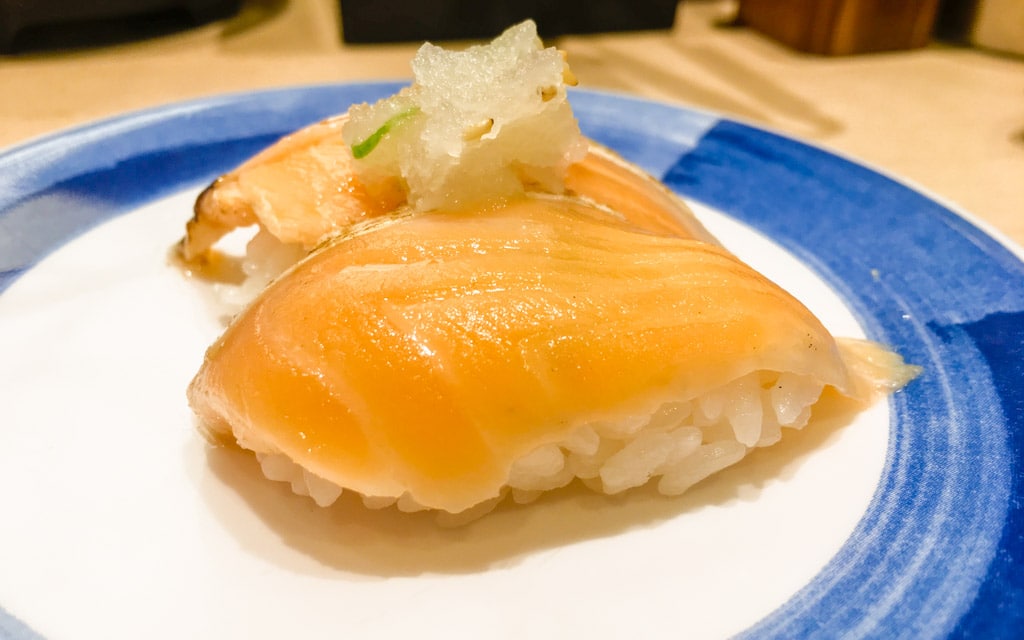
After trying the fatty salmon, I saw a similar option going around, the Roast Fatty Salmon (Yaki Salmon Harasu).
Strangely, the roast fatty salmon wasn’t roasted or seared. I really wanted that smoky, umami flavor
The fish tasted fishy and was somewhat bland. I wasn’t getting that fresh salmon flavor that should have been present. And, the wasabi was missing which was disappointing. The ginger was the only thing that added flavor.
While the salmon wasn’t chewy, it was missing that melt-in-your-mouth texture that I have come to expect with eating salmon.
Jumbo Shrimp (Ebi) – 346 Yen
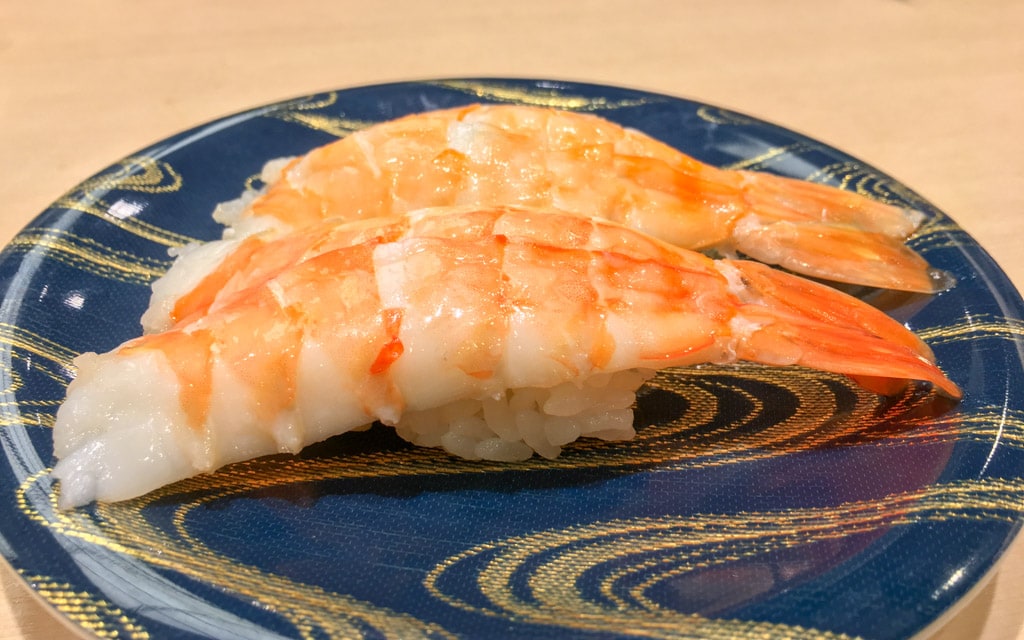
The Jumbo Shrimp (Ebi) looked beautiful, with two large pieces of bright shrimp.
The shrimp was not the most tender or delicate piece I have ever had, but I enjoyed the meaty texture. I believe the shrimp was steamed, giving a chew to each bite without being stringy or fatty.
Each shrimp had fresh, salty flavors with a hint of sweetness.
While I prefer sweet shrimp, I thought the jumbo shrimp was a great value for the price.
Tuna with Green Onions (Negi Toro) – 146 Yen
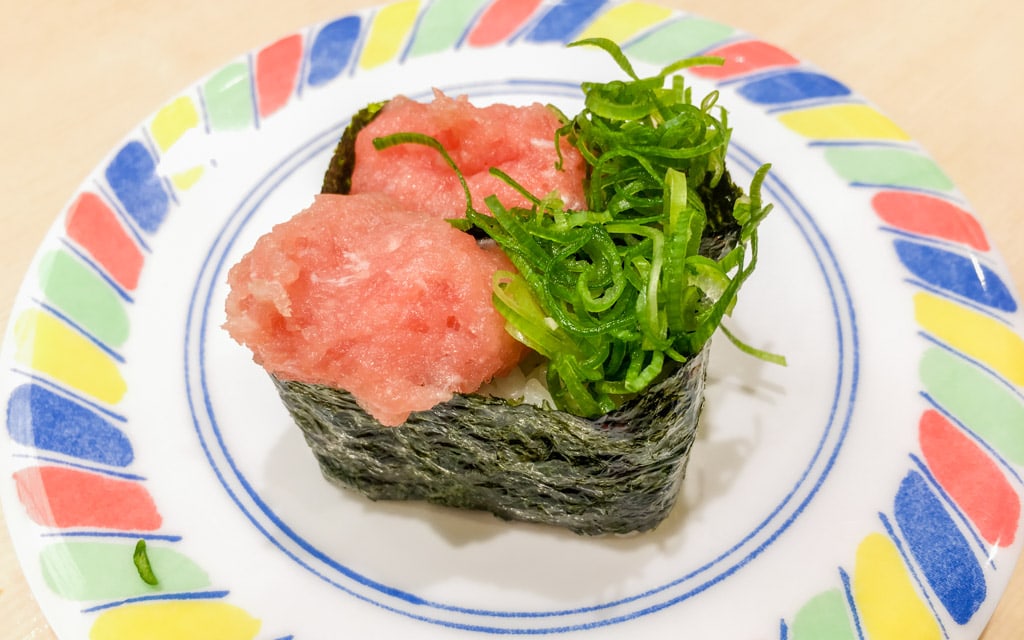
Just when I thought I was full, I saw the Tuna with Green Onions (Negi Toro) pass by on the conveyor belt. It was just too beautiful to pass up.
This battleship sushi was made by topping rice with minced tuna and green onions, then wrapping it in seaweed (nori).
The minced tuna was delicious. It was fresh and salty with a smooth, creamy texture. The green onions added a crunchy texture. Also, I think there may have been some ginger mixed in with it.
Just as with the salmon roe sushi, I was disappointment by the seaweed. The nori could have been crispier.
Service
While interaction with the staff was limited, the servers were friendly and always waiting around to be called at a moment’s notice. Freshly prepared sushi dishes arrived quickly and so did the beers that I kept on ordering.
Conclusion
While there are much better options for sushi in Kyoto, for the price, I would recommend Sushi no Musashi.
Sure, I wouldn’t consider it the best sushi in Kyoto, but that’s not why you would want to come here. You come to Sushi no Musashi for the cheap, affordable, quality sushi in a quick and casual environment. You could eat as little or as much as you wanted and move on without breaking the bank.
I am a big fan of conveyor belt sushi, so not surprisingly I enjoyed Sushi no Musashi. If you want a more intimate, traditional sushi experience in Kyoto, then you might need to look elsewhere.
Pros
- Affordable
- Quality sushi for the price
Cons
- Usually a line, especially during lunch and dinner hours
- Many items unavailable
- Blowfish was a letdown
Hours
Monday - Sunday: 10:00 AM - 10:30 PM
Address
Sushi no Musashi is located at Atsy Road inside Kyoto Station. Atsy Road is located near the Shinkansen Hachijo entrance on the southern side of Kyoto Station.
8-3 Higashishiokoji Takakuracho, Kyoto, Japan
GPS Coordinates: 34.984709,135.759437
Map
Last Updated on October 14, 2024

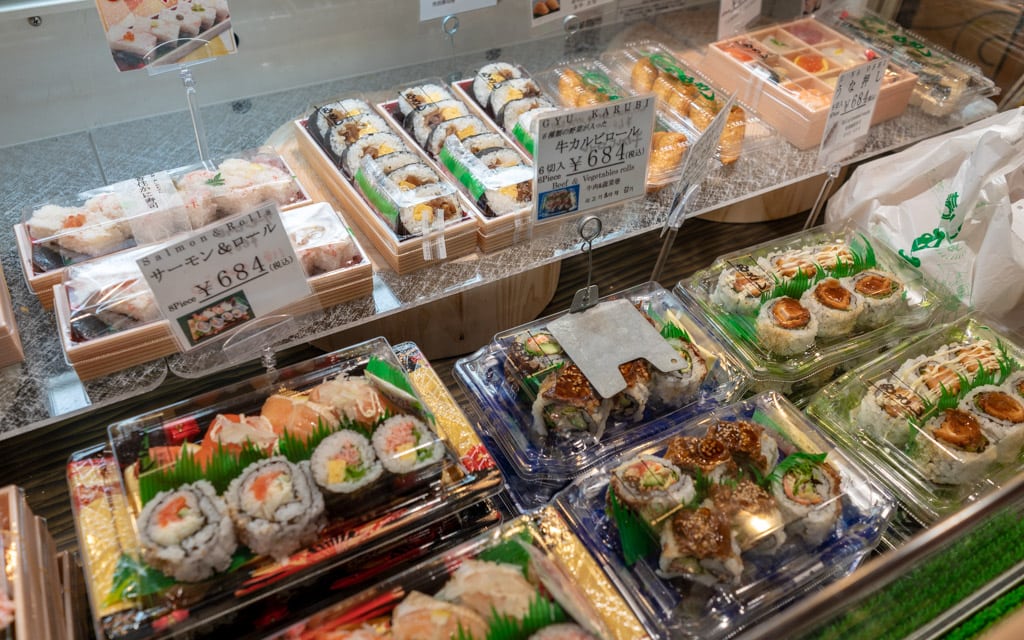

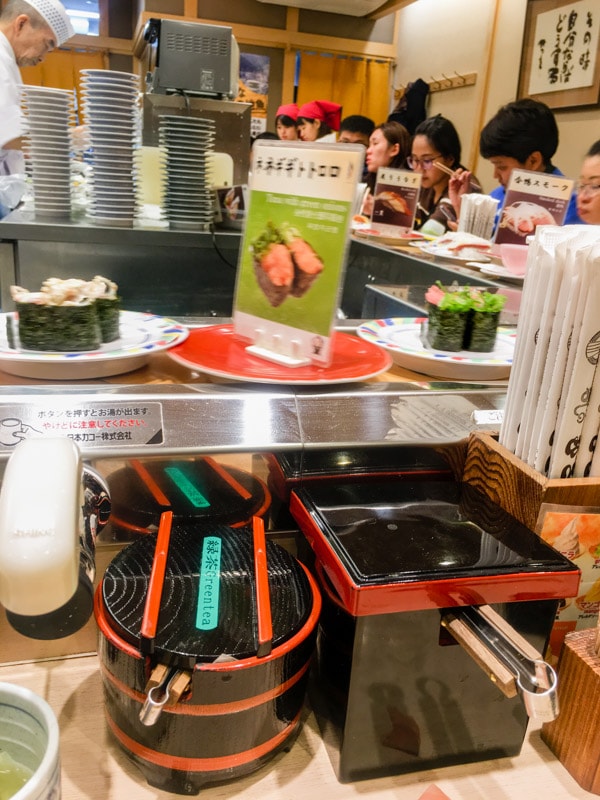

Related Posts